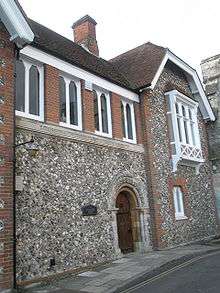Archdeacon of Chichester

The post of Archdeacon of Chichester was created in the 12th century, although the Diocese of Sussex was founded by St Wilfrid, the exiled Bishop of York, in AD 681. The original location of the see was in Selsey. The see was moved to Chichester, in about 1075, by decree of the Synod of London.[1] The incumbent is the Venerable Douglas McKittrick.[2]
History
After the Norman Conquest a uniform system of territorial archdeaconries was created to try to ensure that no settlement was more than a day's ride from the bishop's seat. In 1070 the Council of Windsor decreed that bishops should appoint archdeacons to their churches. The archdeacon acted as the bishop's deputy and representative and had the job of supervising parish churches in the diocese.[3]
Saint Richard, Bishop of Chichester in the 13th century, produced a body of statutes which included the duties of his archdeacons: "They were to administer justice for their proper fees, not demanding more for the expedition or delay of business. They were to visit the churches regularly to see the services were duly celebrated, the vessels and vestments in proper order, the canon of mass correctly followed and distinctly read."[4]
The modern role of an archdeacon in the Church of England has not changed significantly since St Richard's time, their main function is to be involved with legal and practical matters concerning visitations, clergy care, discipline matters, faculties and quinquennial inspections.[5]
The Diocese of Chichester almost exactly covers the counties of East and West Sussex and the City of Brighton and Hove, stretching for nearly a hundred miles (160 km) along the south coast of England. The diocese has four archdeaconries, namely the Archdeaconry of Horsham, the Archdeaconry of Hastings, the Archdeaconry of Brighton and Lewes as well as the Archdeaconry of Chichester.[6]
From its creation in the 12th century until 2002 the Archdeacon of Chichester was actually based in Chichester; however, since 2002, the base has moved to Church House in Hove, East Sussex.[6][7]
List of archdeacons
High Medieval
Late Medieval
|
Early modern
Late modern
|
See also
Notes
- 1 2 3 4 These archdeacons are not referred to as Archdeacon of Chichester, but rather appear to be the sole archdeacon in the diocese.
- 1 2 3 4 5 These archdeacons are not referred to as Archdeacon of Chichester, but are each the senior of two concurrent archdeacons of the diocese.
References
- ↑ Kelly. The Bishopric of Selsey in Mary Hobbs. Chichester Cathedral: An Historic Survey. pp.1 - 10
- ↑ Diocese of Chichester — Other Staff
- ↑ Bartlett. England under the Norman and Angevine Kings pp.388 - 389
- ↑ Stephens. The South Saxon Diocese. p.67
- ↑ Synodical Government, p.65.
- 1 2 Diocese of Chichester Website
- ↑ .The Brighton Evening Argus. Announcing McKittrick replacing Michael Brotherton and moving to Hove. Retrieved 18 September 2013
- ↑ MOUNT, Ven. Francis John. Who Was Who. 1920–2008 (December 2007 online ed.). A & C Black, an imprint of Bloomsbury Publishing plc. Retrieved 3 January 2013.
- ↑ ELWES, Ven. Edward Leighton. Who Was Who. 1920–2008 (December 2007 online ed.). A & C Black, an imprint of Bloomsbury Publishing plc. Retrieved 3 January 2013.
- ↑ JONES, Rt Rev Herbert Edward. Who Was Who. 1920–2008 (December 2007 online ed.). A & C Black, an imprint of Bloomsbury Publishing plc. Retrieved 3 January 2013.
- ↑ HOSKYNS, Ven. Benedict George. Who Was Who. 1920–2008 (December 2007 online ed.). A & C Black, an imprint of Bloomsbury Publishing plc. Retrieved 3 January 2013.
- ↑ CLARKE, Ven. Charles Philip Stewart. Who Was Who. 1920–2008 (December 2012 online ed.). A & C Black, an imprint of Bloomsbury Publishing plc. Retrieved 3 January 2013.
- ↑ MASON, Ven. Lancelot. Who Was Who. 1920–2008 (December 2012 online ed.). A & C Black, an imprint of Bloomsbury Publishing plc. Retrieved 3 January 2013.
- ↑ KERR-DINEEN, Rev. Canon Frederick George. Who Was Who. 1920–2008 (December 2012 online ed.). A & C Black, an imprint of Bloomsbury Publishing plc. Retrieved 3 January 2013.
- ↑ EYRE, Very Rev. Richard Montague Stephens. Who's Who 2013 (December 2012 online ed.). A & C Black, an imprint of Bloomsbury Publishing plc. Retrieved 3 January 2013.
- ↑ HOBBS, Rev. Canon Keith. Who Was Who. 1920–2008 (December 2012 online ed.). A & C Black, an imprint of Bloomsbury Publishing plc. Retrieved 3 January 2013.
- ↑ BROTHERTON, Ven. (John) Michael. Who's Who 2013 (December 2012 online ed.). A & C Black, an imprint of Bloomsbury Publishing plc. Retrieved 3 January 2013.
- ↑ McKITTRICK, Ven. Douglas Henry. Who's Who 2013 (December 2012 online ed.). A & C Black, an imprint of Bloomsbury Publishing plc. Retrieved 3 January 2013.
Sources
- T. F. T. Baker, C. R. Elrington (Editors), A. P. Baggs; et al. (1980). "Friern Barnet: Churches". A History of the County of Middlesex: Volume 6: Friern Barnet, Finchley, Hornsey with Highgate. Institute of Historical Research. Retrieved 11 June 2010.
- Bartlett, Robert (2000). J. M. Roberts, ed. England Under the Norman and Angevin Kings 1075 -1225. London: OUP. ISBN 978-0-19-925101-8.
- "Chichester Diocese Website". Diocese of Chichester. Retrieved 9 June 2010.
- Hennessy, George (1900). Chichester Diocese Clergy Lists: Clergy Succession from the earliest time to the year 1900. London: St Peters Press.
- General Synod (1997). Synodical Government in the Church of England. London: Church House Publishing. ISBN 0-7151-3806-5.
- Mary Hobbs, ed. (1994). Chichester Cathedral: An Historic Survey. Chichester: Phillimore. ISBN 0-85033-924-3.
- Stephens, W. R. W. (1881). The South Saxon Diocese, SELSEY - CHICHESTER. London: SPCK.
- "The Argus, Brighton and Hove". The Argus. Retrieved 11 June 2010.
- Greenway, Diana E., Fasti Ecclesiae Anglicanae 1066–1300 5, pp. 20–23
- Horn, Joyce M., Fasti Ecclesiae Anglicanae 1300–1541 7, pp. 11–13
- Horn, Joyce M., Fasti Ecclesiae Anglicanae 1541–1857 2, pp. 15–17
| ||||||||||||||||||
| ||||||||||||||